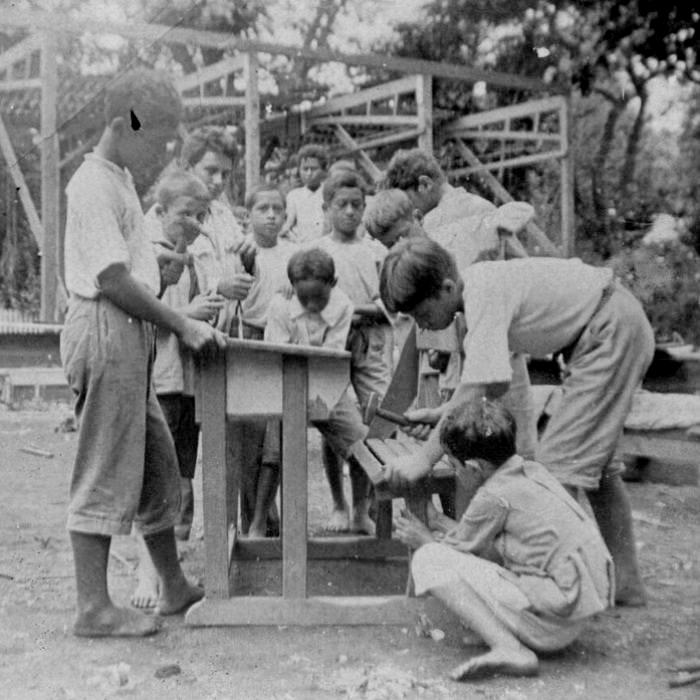
French Polynesia: Education

Figure 1.-- This photograph was taken in 1920s at the primary school of the Evangelical Mission of Papeete. Papeete is the capital of French Polynesia, located on the main island of Tahiti. The school had separate classes for boys and girls. Here the boys are engaged in assembling a school desk. It seem that some pupils were French. The missionaries' children presumably attended the school. The clothing is similar for all boys. All are wearing similar shirts and knee-length trousers and all are barefoot.
|
|
French Polynesia is an Overseas Territory that includes Tahiti and 118 smaller islands in the eastern South Pacific. There are five major islands (archipelagos): Society Islands, which include Tahiti and Moorea; the Marquesas Islands; the Austral Islands; the Tuamotu Archipelago; and the Gambier Islands. The first schools in French Polynesia were the French missionary schools. Several different churches established mission schools, but we have not yet found much information about them. We are not sure when the French administration began opening public schools. We believe this was primarily a development after World War II. France has over time granted French Polynesia, now an Overseas Territory, greater autonomy in most local affairs and regional relations but retained control of law enforcement, defense, the money supply, and education. State public schools are run by the French administration and comply with French standards. The French have established primary, secondary, and vocational schools Formal education on Tahiti is now compulsory for every child up to 14 years of age. Primary education begins at age 5 years and continues until the children are 12 years old at which time they begin secondary school. There are a number of technical and vocation schools in Tahiti, including hotel, restaurant, nursing and teaching programmes. There is also an imprtant adult education program. Education at these facilities is free. French Polynesians are able to attend college in France or pursue a degree at the French University of the Pacific (UFP), which has a campus in French Polynesia. Something like 95 percent of the population is literate, some estimates are even higher. There is now gender differential. The schooling is conducted in the French language using the same syllabus as schools in France for most subjects. This meant that until recently as French has become more common, most children begin school which was taught in a foreign language. A large part of the population spoke Tahitian rather than French, especially on the smaller islands outside Tahiti. Tahitian continues to be important in everyday life. The French were very strict with this, banning Tahitian was in schools for both teachers and students. This included both in the classroom and during recess and other times outside the classroom. Current school policy is more tolerant and a few hours per week of Tahitian language instruction is now provided at primary and secondary school.
Tahitian literacy is maintained in adult life mainly through the writing of personal letters, now the internet, and the reading of religious texts. Tahitian continues to be widely used in radio broadcasting, popular music, and personal contact with Tahitian speakers. French and Tahitian are both official languages. Tahitian is a kind of lingua franca among Polynesian groups and in religious education at Protestant and Catholic schools, although even in these schools, secular subjects are taught in French. The private religious schools, partially supported by the French administration, use the same basic curiculum as the public schools with religious instruction added. Thoughout Oceania, nationalist groups seek to introduce local languages like Tahitian into the schools. This is a complicated topic. As a matter of social justice, people should have the opportunity to learn in their own languages. By not learning French, however, people are cutting themselves off from the wider world and economic opportunity. Only so many books are available in Tahitian or other local languages. This includes both literarure and technical books. Thus not learning French cuts the individual off from modern technology.
On the outer islands such as Tuamotu, there is a high dropout rate with less than 20 percent of the children finishing primary school. Language policy may be a factor here, but there are other economic and cultural factors involved as well.
HBC-SU

Related Chronolgy Pages in the Boys' Historical Web Site
[Late 19th century]
[The 1930s]
[The 1940s]
[The 1930s]
[The 1940s]
[The 1950s]
[The 1960s]
[The 1970s]
[The 1980s]
Related Style Pages in the Boys' Historical Web Site
[Long pants suits]
[Knicker suits]
[Short pants suits]
[Socks]
[Knits]
[Jacket and trousers]
[Blazer]
[School sandals]
Navigate the Boys' Historical Clothing Web Page
[Return to Main Oceania school page]
[Return to Main national school page]
[Return to Main French Polynesia page]
[Introduction]
[Activities]
[Biographies]
[Chronology]
[Clothing styles]
[Countries]
[Bibliographies]
[Contributions]
[FAQs]
[Glossary]
[Images]
[Links]
[Registration]
[Tools]
[Boys' Clothing Home]
Created: 8:25 AM 1/10/2013
Last updated: 8:25 AM 1/10/2013




